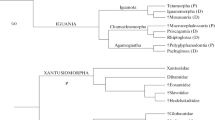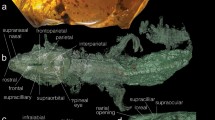Abstract
A new lizard, Tsagansaurus nemegetensis gen. et sp. nov., from the Late Paleocene of southern Mongolia is described. It is assigned to the extinct family Parasaniwidae (Platynota, Anguimorpha). The new taxon is the latest representative of this group in the fossil record.
Similar content being viewed by others
REFERENCES
Alifanov, V.R., Macrocephalosaurs and early stages of the evolution of lizards of Mongolia, Tr. Paleontol. Inst. Ross. Akad. Nauk, 2000, vol. 272, pp. 1–126.
Alifanov, V.R., Order Lacertilia, in Iskopaemye pozvonochnye Rossii i sopredel’nykh stran. Iskopaemye reptilii i ptitsy. Chast’ 2 (Fossil Vertebrates of Russia and Adjacent Countries: Fossil Reptiles and Birds: Part 2), Kurochkin, E.N. and Lopatin, A.V., Eds., Moscow: Geos, 2012, pp. 7–136.
Badamgarav, D. and Reshetov, V.Yu., Paleontology and stratigraphy of Paleogene of Transaltai Gobi, Tr. Sovm. Sovet.-Mongol. Paleontol. Eksped., 1985, vol. 25, pp. 1–104.
Borsuk-Białynicka, M., Anguimorphans and related lizards, Palaeontol. Polon., 1984, no. 46, pp. 5–105.
Conrad, J.L., Phylogeny and systematics of Squamata (Reptilia) based on morphology, Bull. Am. Mus. Natur. Hist., 2008, no. 310, pp. 1–182.
Dong, L., Evans, S.E., and Wang, Y., Taxonomic revision of lizards from the Paleocene deposits of the Qianshan Basin, Anhui, China, Vertebr. PalAsiat., 2016, vol. 54, no. 3, pp. 243–268.
Estes, R., Fossil vertebrates from the Late Cretaceous Lance Formation of Eastern Wyoming, Publ. Geol. Sci. Univ. California, 1964, vol. 49, pp. 1–180.
Estes, R., Handbuch der Paläoherpetologie: Encyclopedia of Paleoherpetology, vol. 10A: Sauria terrestria, Amphisbaenia, Stuttgart–New York: G. Fisher, 1983.
Gauthier, J.A., Kearney, M., Maisano, J.A., et al., Assembling the Squamate tree of life: Perspectives from the phenotype and the fossil record, Bull. Peabody Mus. Natur. Hist., 2012, vol. 53, no. 1, pp. 3–308.
Lee, M.S.Y., The phylogeny of varanoid lizards and affinities of snakes, Philos. Transact. R. Soc. B Biol. Sci., 1997, vol. 352, no. 1349, pp. 53–91.
Lopatin, A.V., Early Paleogene insectivore mammals of Asia and establishment of the major groups of Insectivora, Paleontol. J., 2006, vol. 40, suppl. no. 3, pp. 205–405.
Maisano, J.A., Bell, C.J., Gauthier, J.A., and Rowe, T., The osteoderms and palpebral in Lanthanotus borneensis (Squamata: Anguimorpha), J. Herpetol., 2002, vol. 36, no. 4, pp. 679–682.
Norell, M.A. and Gao, K., Braincase and phylogenetic relationships of Estesia mongoliensis from the Late Cretaceous of the Gobi Desert and the recognition of a new clade of lizards, Am. Mus. Novit., 1997, no. 3211, pp. 1–25.
ACKNOWLEDGMENTS
This study was supported by the Russian Foundation for Basic Research, project no. 16-05-00408.
Author information
Authors and Affiliations
Corresponding author
Additional information
Translated by G. Rautian
Rights and permissions
About this article
Cite this article
Alifanov, V.R. A New Platynotan Lizard (Parasaniwidae, Anguimorpha) from the Late Paleocene of Southern Mongolia. Paleontol. J. 52, 1432–1435 (2018). https://doi.org/10.1134/S0031030118120067
Received:
Published:
Issue Date:
DOI: https://doi.org/10.1134/S0031030118120067




